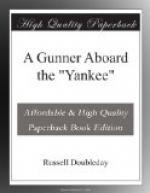“Doesn’t make any difference whether you can see or not,” he exclaimed. “Shoot anyway. Give it to the beggars! That’s the ticket, old chap. Now another. Whoop! did you see that land? Ah-h-h! we are the people.”
As the novelty of the scene gradually wore off we began to enjoy it hugely. We pumped away at the guns, commenting freely on the enemy’s marksmanship. We felt more like a party watching a fireworks display than the crew of a warship engaged in bombarding a number of forts.
The two lines were steaming back and forth in front of the batteries, firing as the guns would bear. At first, Morro Castle and the smaller forts maintained a spirited fire, but finally their response to our fusillade slackened considerably, and it became evident that they had been driven from their guns.
The difference in aim between the Spanish gunners and ours was very perceptible. Their shells invariably passed over the ships or landed short, and at no time during the engagement were any of the American vessels in imminent danger. This was not due to length of range either, as the lines were maintained at from two to four thousand yards. As Bill put it, “Any Dago that can’t hit a flock of barn doors like this fleet, had better go back home and hoe onions.”
The ships of our fleet also made better targets than did the batteries ashore. It was certainly easy to distinguish the position of each vessel, but as the Spanish batteries were nearly all situated a short distance back from the crest of the ridge with a background little different in color from that of the battery, we found it difficult to locate them at times. Our elevation had to be perfect, as with an inch or two below or above, the projectile would either vanish in the distance or take effect on the cliffs below the batteries.
We of Number Eight gun, when the “Yankee” was steaming with the starboard broadside bearing, managed to slip across the deck and watch the firing from the ports and deadlights. It was really beautiful to see the landing of the great shells upon the forts and surrounding earth. Some battered into the soft spots on the cliffs, sending huge masses of dirt and debris high into the air; then when the explosion came, there would follow a great cloud of dust resembling the wavering smoke over a city fire.
Others struck the harder portions of the cliff, bursting into a shower of fragments, each kicking up its own pother of dirt and shattered rock. At times a shell would land in a crack in the face of the hill, and immediately following would come an upheaval of stones. These boulders, many of them of immense size, would roll down the slope and splash in the water at the base, creating a series of fountain-like cascades.
Accompanying the display was a continuous roar of explosion and detonation that echoed and reechoed across the water like the pealing of tropical thunder. In fact, it was these noises, mingled with the fierce reports of our guns, which impressed us the most. Taking it all in all, the scene was spectacular in the extreme.




